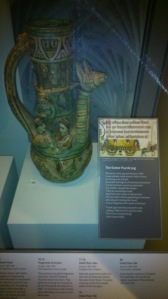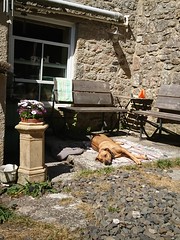Where Do Stories Start?
A couple of weeks ago, I was given a firm instruction to write a bit more about the process of writing. So, just for those who asked, here are some more musings on the world of scribbling.
Planning a story is a pain. Really, it is. I always characterise my work as being 9/10ths day dreaming – and not many people can claim to have a job like that.
But day dreamers still need food for thought. I have to have a basic level of understanding about a period, a scene, a moment in politics – something – before I can even begin to think about a plot.
Well, that’s the easy part. I’ve been fascinated by history for all my life, and reading and researching aspects of the various periods I’ve written about has been a joy, not a chore. Over the last twenty-odd years since I started writing, I’ve collected a library that serves me well. And almost all the books in it have been eagerly absorbed. If you are going to write about history, you need a solid grounding in the history, because otherwise you will not be able to convince the reader.
But if you have the grounding, you have the period, the politics, the social history – where do you start inventing a story?
I usually start with a little snippet I’ve read or heard of. A silly comment, a newspaper article, anything can spark an idea. Either a thought of modern life and how would that have struck Simon or Baldwin, or a situation that drives me so potty I have to write about it (as happened with Act of Vengeance).
Yesterday I was enormously grateful to Tom Cadbury of the RAM Museum in Exeter, who took me around and showed me a few of his favourite items on display. He stopped after showing me the excellent display of flint axes and other hand tools, and said, “What would Baldwin have made of that?”
My immediate reaction was, that Simon would have picked it up for a moment and tossed it aside, but perhaps Baldwin would have looked and puzzled over its shape for a few moments.
However, it gave me pause for thought. There are so many little ideas that occur, and to be honest, most have always flitted out of my mind faster than they entered. Which is why now I use a Midori Traveller’s Notebook. I recommend it to anyone who’ll listen, but it’s not the maker that matters, it’s the fact that you need a notebook that will be with you at all times. Yes, I used to use a tablet and my phone – but I’m reverting to older technology because it’s safer. Notebooks don’t get broken, wiped, or lose data because of a power surge or cut. My Midori has notes of various ideas that come to me wherever I am, and many will make it into books.
Back to RAMM – in amongst the broken jugs there were some excellent (possible) stories, such as: why were so many good quality jugs found at the bottom of a well? My own mind immediately brought up a novice’s expression of frozen horror as he peered down into the well having dropped his canon’s best jugs. It’s an idea to fix on, I think – ideal for a camera shot from inside the well looking up, if there are any producers reading this!
A few exhibits further over was another jug, a so-called “puzzle” jug, which was made in about 1300. It has a tower design, with holes cut into the sides all the way up, and figures leering out. Any liquid would appear to be at risk of pouring straight out through all these holes, but the clever design incorporates a hollow handle. Liquids pour down that into the reservoir at the bottom.
This is my photo,
but you can see it better here: The Puzzle Jug, Royal Albert Memorial Museum, Exeter.
Because of its decoration and the skill of its French designers, it was of enormous value, and Tom speculated that it would probably have been owned by a bishop or someone of similar standing. That again led to me thinking of Stapledon and wondering whether he owned it himself, or whether he had seen and handled it in the house of a wealthy friend, perhaps.
On the other hand, it could have a more mundane story. Perhaps it was seen by a thieving English soldier during the Crécy campaign and brought home on his return?
These are all raw ideas for stories. They are hooks that get my interest, nothing more. But hooks are crucial to writers. It is the sprinkling of little details of historical fact through my books that, I think, give them their realism, and which make the reader occasionally blink and pause to rethink a little detail of life.
One such example I often use was the medieval treatment of animals.
Nowadays we think of medievals as merely cruel for the sake of cruelty. If you hear about cats being put in a sack and beaten to death, or of dogs having burning bushes tied to their tails, or cock, dog fighting, or bull and bear baiting, it’s hard to see the people as kind towards animals.
Yet I would contend that our ancestors had more natural kindness to animals generally. They grew up with animals and understood them.
In my village there is an old farmer who still has a fair dairy herd. He has grown up around animals, looking after the calves until they grew to a marketable age and size, and then sold them on. There is not much space for sentiment in a farmer’s life.
However, in the back field near his house there is a little mound. That is where one of his old cows is buried. She was with him from birth, and she went with him like a dog when he tramped out across the fields. When she was too old and couldn’t give any more milk, he didn’t send her to the abattoir, but kept her for several more years until she died of natural causes.
Compare that with the way that, during foot and mouth, men would round up herds and shoot them in their hundreds, before piling them up and setting fire to them. There are stories still murmured with horror down here in the West Country about some of the vile men involved laughing and joking as they slaughtered their victims. Perhaps they would have been instantly recognisable to their medieval ancestors.
Similarly I’ve know many men who hunt game. Those who trap rabbits, and who spent time with each one, stroking them and calming them for a minute or two, before despatching them with a quick movement. Cruel people wouldn’t have taken that effort. But it is a part of country life, to ease the passing of other animals – to give to each a degree of respect.
It’s only by thinking carefully about all these little hooks that the story starts to develop.
So, having the hooks set out, it’s time to write the story…
But that’s for next time!






My planning, if you can call it that, is nothing more than a series of specific ideas with maybe the odd additional comment written after each one. :)
LikeLike
I have to have start points – it’s the little details that usually kick me off.
LikeLike